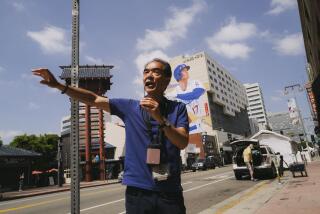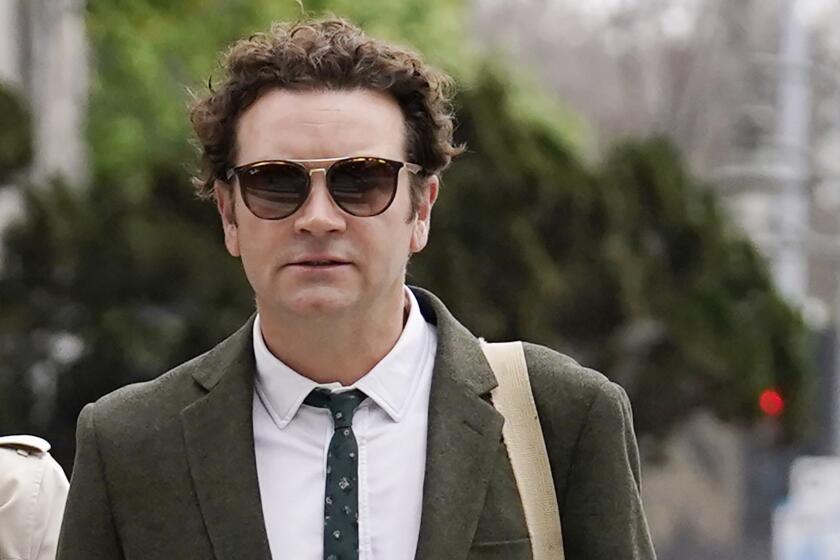Japan leader Shinzo Abe reaches out to Japanese Americans in L.A. visit
For decades, an uneasy ambivalence marked the relationship between Japan and many Japanese Americans after the Asian nationâs 1941 attack on Pearl Harbor prompted the communityâs mass removal from the West Coast and incarceration in desolate compounds.
But in his first state visit to Los Angeles on Friday, Japanese Prime Minister Shinzo Abe seemed to take pains to reach out to Japanese Americans with appearances honoring their war veterans and touring their national museumâs exhibit on the communityâs history.
In Little Tokyo, the historical heart of Japanese America, Abe presented a wreath of white lilies, roses and chrysanthemums at the Go for Broke monument, which honors more than 16,000 Japanese American veterans who served overseas during World War II.
The visit, the first by a Japanese prime minister, thrilled the seven veterans who turned out in their blue service caps to shake hands and pose for pictures with Abe.
âI was shocked he would take the time to drop by, but it was really nice he came to see us despite the fact that a few of us fought against his country,â said Ken Akune, 91, who served as an interrogator and translator for the U.S. Military Intelligence Service and later assisted in the war crimes trial of Japanese General Hideki Tojo.
Abe later toured the Japanese American National Museum and met with community leaders at an evening reception.
âThis visit is historic for our museum,â said Greg Kimura, who heads the institution. âHistorically, there has been this ambivalence toward Japan over the decades because of the war, but there has been a lot of reconciliation. A lot of those old wounds have been healed.
âUltimately, we are cousins whether removed generations or just a few years,â he said.
Abe also thanked Japanese Americans during a luncheon address at the Biltmore Hotel, praising their âtremendous efforts to recover American confidence in Japanâ after the war, according to the Rafu Shimpo, a Japanese American newspaper.
In his remarks, Abe confirmed that the Japanese government planned to open a âJapan Houseâ in Los Angeles, one of three in the world aimed at showcasing the countryâs cutting-edge technology and its traditional and popular culture. Japanese media have reported that officials hope the project will increase international support for Japan amid disputes with China and South Korea.
Jon Kaji, a Japanese American businessman, said Abeâs outreach seemed to underscore new interest by Japan in both Little Tokyo and the United States market. Many Japanese firms abandoned Little Tokyo after the deep recession of the 1980s, but Kaji said he is working with various business groups interested in possible new investments. Among other things, Kaji hopes to lure the Japan House project to Little Tokyo.
Earlier this week, Abe touted Japanâs high-speed rail technology to Gov. Jerry Brown with a simulation of the nationâs famous Shinkansen bullet train. He also tested an all-electric Tesla car and spoke about technological innovation at Stanford University.
His appearances in California were marked by protesters demanding stronger apologies by Japan for such wartime atrocities as the Nanking massacre and the forced sexual servitude of âcomfort womenâ for Japanese troops throughout Asia.
In Little Tokyo, however, a handful of Abe supporters waved papers printed with the red sun of Japan as the prime ministerâs motorcade went by. Yoshiko Ueda, who owns a graphic design store in Little Tokyo, said Abeâs visit reflected the reconciliation between the one-time war enemies.
âWe have a very bad history between the two nations because of the war, but the United States forgave us, and the forgiveness makes a new start,â she said.
Twitter: @TeresaWatanabe
More to Read
Sign up for Essential California
The most important California stories and recommendations in your inbox every morning.
You may occasionally receive promotional content from the Los Angeles Times.











